
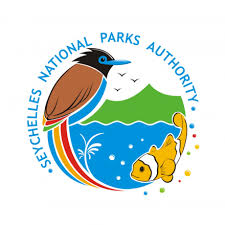
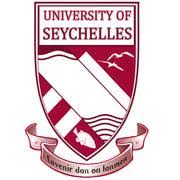
BGF#2
Type: Large
SeyCCAT strategic objective: Support new and existing marine and coastal protected areas and sustainable use zones.
Lead Project Partner: Global Vision International – Seychelles.
Partners: Seychelles National Parks Authority, University of Seychelles, James Michel Blue Economy Research Institute.
Summary: The sicklefin lemon shark (Negaprion acutidens; Ruppell 1835) is categorized as vulnerable (IUCN 2014), in part due to its coastal preference and consequent proximity to human activity, and it faces many threats to its continued survival. The species is fished throughout its range (Compagno 1990), and its small habitat range and limited movement patterns make it susceptible to local depletion since dispersal is limited (Stevens 1984, Stevens et al. 2000, Shultz et al. 2008). For effective protection of shark species it is important to gain an understanding of spatial movements and habitat preferences of critical life stages. The installation of an acoustic receiver array along the north and east coast of Curieuse Island, together with the acoustic tagging of 20 neonates, will enhance our knowledge of N.acutidensspatial ecology. Furthermore, results from this project will enable MPA practitioners to make informed future recommendations with regards to the protection of this particular species. Curieuse Marine National Park (CMNP), designated in 1979, is 2.9km2and located north of Praslin Island and a key tourism site in the inner islands. The island is surrounded by a shallow fringing reef and seagrass beds and has a healthy stand of mangroves. These habitats serve as key sea turtle feeding and nesting grounds as well as providing nursery habitat for key ecological species such as N. acutidens
The overall outcome of this project will be a greater understanding of the movements of neonate N. acutidens within CMNP and the efficacy of the park size in their protection. The main objectives are:
- Obtain an improved understanding of spatial behaviour and habitat use of 20 neonate acutidenswithin CMNP by monitoring their movements for six months using acoustic transmitters.
- Refine mark-recapture population estimates of neonate acutidenswithin CMNP within 18 months
- Develop local capacity by training at least 10 Seychellois stakeholders and MPA practitioners in shark research techniques by December 2019.
- Contribute to national efforts to protect biodiversity by identifying areas of critical habitat within and outside CMNP used by the threatened species, neonate acutidens within 18 months
- Provide critical habitat data to national park managers and stakeholders within CMNP and other protected areas to better inform management decisions regarding the conservation of acutidens within 18 months
Outputs will include maps showing the movement and critical habitat areas of neonate N. acutidensin CMNP, a training workshop for Seychellois stakeholders and students in shark research techniques, a signboard providing information on the project and a peer-reviewed scientific paper on the findings of the project. These outputs will be enabled by activities to include the installation of an acoustic receiver array and implantation of acoustic receivers in neonate N. acutidens, capacity building of staff and students through in-field research experience, and the production of communication materials to disseminate the key findings from the project. The rationale of the project approach is that by collecting data on the movement and habitat use of neonateN. acutidens, a species that is vulnerable to over-fishing, the effectiveness of CMNP in protecting the critical life stage can be assessed. There would be a wide range of beneficiaries associated with this project including SNPA, protected area managers, shark biologists, university students and local fishers. The project will operate over 18 months, with the following phases: 1) development and training; 2) implementation; and 3) assessment, monitoring and management. The project is well aligned with the objectives of the National Biodiversity Strategy and Action Plan (2015-2020) including: 1.1. To make the Seychelles population aware of the values of biodiversity and the steps they can take to conserve it;3.2. To prevent the extinction and improve the conservation status of known threatened species, particularly those most in decline;5.3. To improve, share, transfer and apply the knowledge, science base and technologies relating to biodiversity, its values, functioning, status and trends, and the consequences of its loss. Finally, the project will contribute to the UN Sustainable Development Goal 14 to “Conserve and sustainably use the oceans, seas and marine resources for sustainable development” under sub-goal 14.2 and 14.a.
SeyCCAT funds: SCR 550 000
Co-financing: SCR 550 000
Duration: January 2019 – June 2020
Project Application Form: Project Application Form
Results
Downloaded data revealed that one individual failed to recover from the surgery, therefore data from 19 sharks was available for analysis, and this proved to be sufficient for all analyses. Data from 16 sharks was included in the spatial analysis.
A total of 292,107 shark detections were used for spatial analysis. 97.7% of all shark activity was recorded in the Turtle Pond, decreasing to Anse Laraie eastwards through Anse Papaie to Grand Anse. As expected, very little activity was recorded on deep receivers, and only for short periods, confirming that resident sharks do indeed restrict the majority of their activity to shallow habitat. A mean 100% minimum convex polygon of 0.434km2, a mean 50% kernel utilisation density of 0.18km2, and a mean step dispersal distance of 41m all showed extremely small home ranges and limited movement patterns, with the vast majority of activity centred in the Turtle Pond. Furthermore, a network plot confirmed that 95% of recorded activity was also restricted to the Turtle Pond, with 4% between the Turtle Pond and Anse Laraie. Cumulative activity plots confirmed that all sharks reached the maximum extent of their ranges within the period of the study, so these results can be considered to be valid.
Activity did, however, extend to Grand Anse, with most sharks making regular brief excursions outside of the Turtle Pond. This confirms that the PIT tagging study has been sampling the entire population rather than only a subsample, and therefore the population estimates are confirmed to represent the whole population. Tracking data was also used to further refine the accuracy of population size estimates by incorporating conclusions into the model development process.
A highly significant discovery has been made, in that high levels of permanent emigration were clearly evident in the detection data. Furthermore, outreach to the Praslin fishing community resulted in the reporting of two PIT tags from sharks caught at Anse Volbert, one of which was returned and scanned. The revelation that emigration is common, combined with the tracking data itself, was used in a detailed modelling analysis, which produced preliminary estimates of the supply of Lemon sharks from CMNP to surrounding habitats of 200 to 250 individuals per year.
Knowledge Sharing
Seminars and workshops have generally been extremely productive. The two seminar at UniSey was very well attended, with interest from a diverse range of attendees. The training workshop attended by GVI and UniSey achieved its intended aims, in that the lead fieldwork personnel are now suitably trained in surgical implantation of transmitters. Training by UniSey partners to 13 GVI and SNPA personnel in transmitter and receiver hardware has also resulted in key personnel being fully conversant in the required techniques. A further training of 7 SIF staff in PIT tagging and transmission insertion surgery.
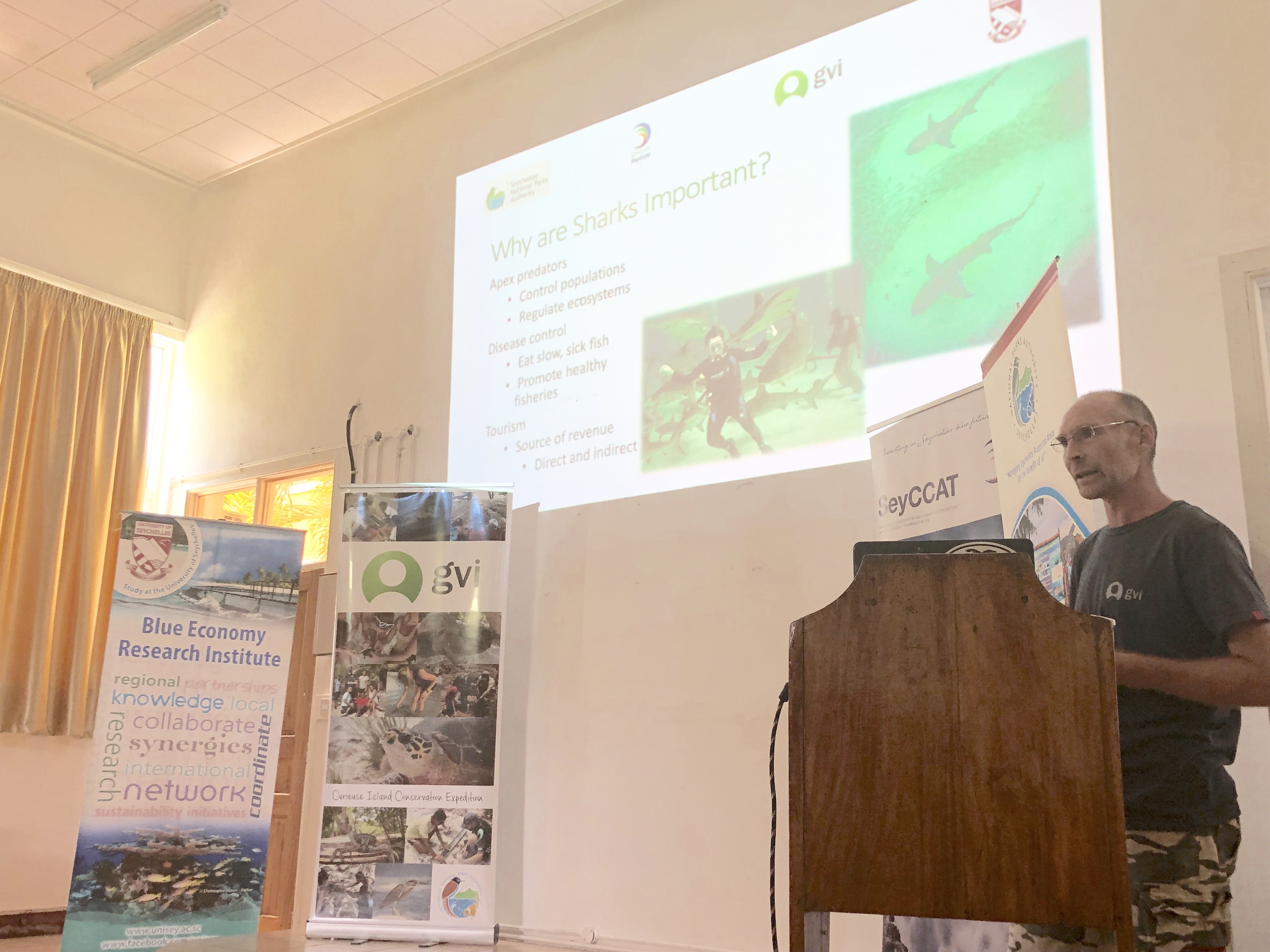

80 people from five continents viewed webinar about the project.
PIT Tagging
Ongoing capture and PIT tagging of juvenile sharks has resulted in the capture of 30 new individuals during 2019, with 23 recaptures.
There has been some engagement with local fishers, with the distribution of posters describing the project resulting in the return of one PIT tag from a neonate shark apparently captured at the east of Anse Volbert on Praslin, this will be used to enhance the conclusions of the study.
Acoustic Tracking
The timeline for implementation of the acoustic tracking requires the final installation of receivers prior to the beginning of the N. acutidens pupping season in October. All tracking hardware has now been procured and thoroughly tested, and software installed on laptops. Despite some initial delays in the importation of the tracking equipment the project is on schedule to achieve its objectives.
Range testing is underway across the study area and will continue until the end of September. Deep sites were somewhat deeper than expected at approximately 27m, and this may result in an adjustment of the receiver deployment plan, since bottom time using SCUBA is significantly reduced at such depths, and reduced visibility resulting in increased searching time to retrieve receivers may require a adjustment of the plan to shallower depths. There is some concern regarding wave action at some shallow deployment sites, monitoring is underway to assess the security of moorings during the range testing, and adjustments may be required to some shallow receiver deployment locations. The definitive assessment will be made at the conclusion of the range testing, using data on detection range, shallow mooring security and practicality of deep moorings to determine the ideal final deployment locations.
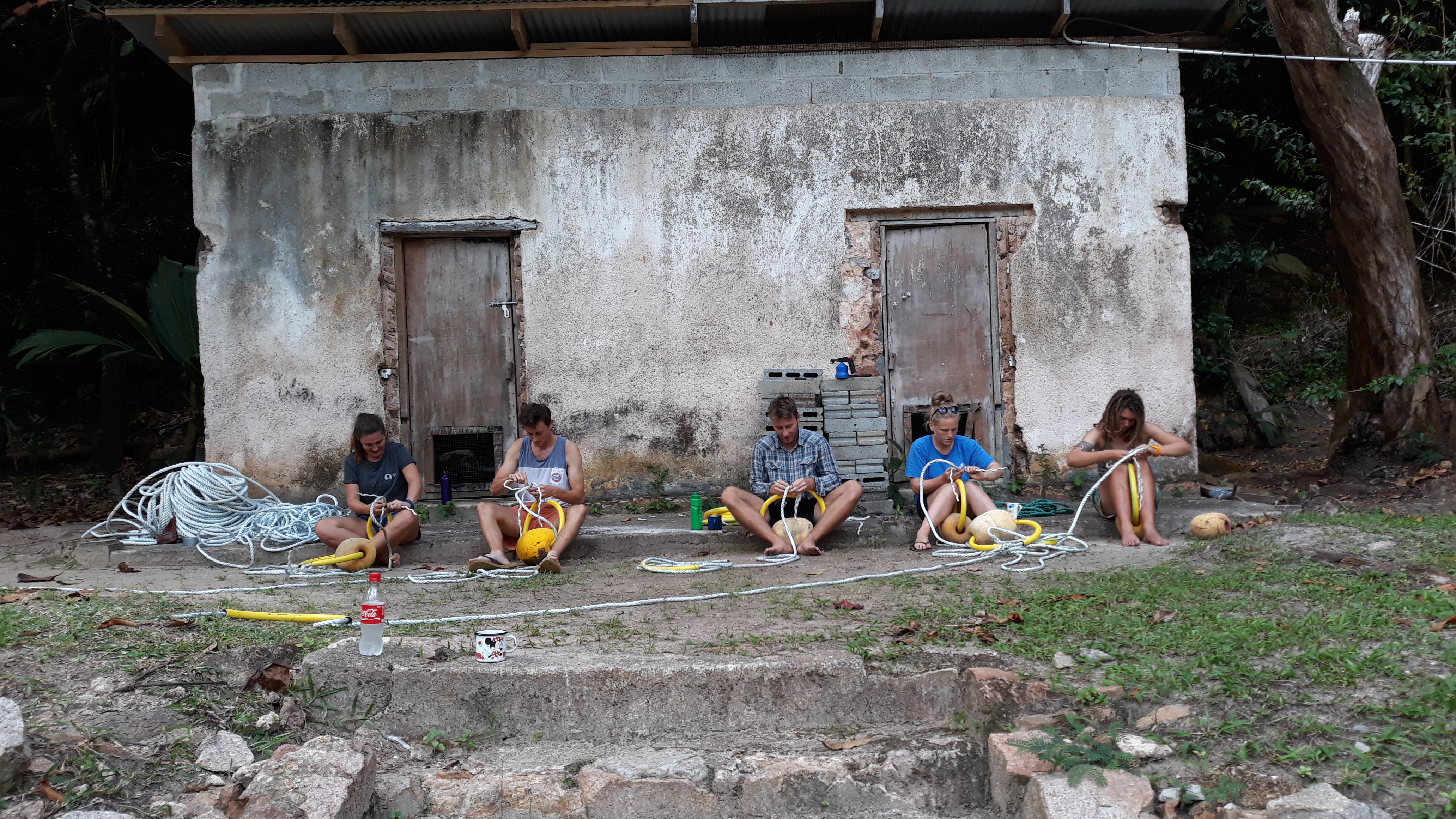
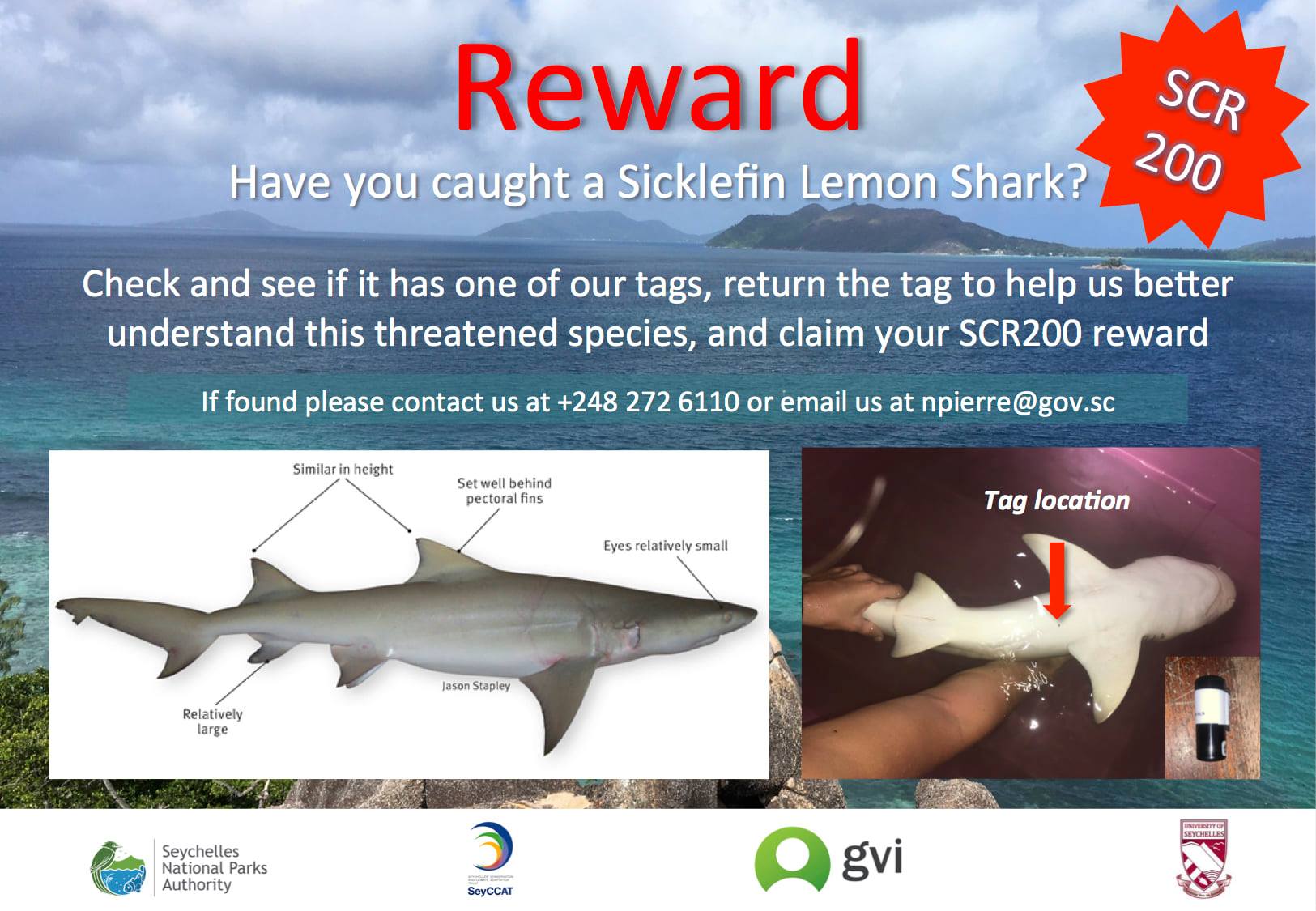
Jazzy from GVI Curieuse Base joined the Seychelles Ocean Symposium
Read more Page 100 – 109 of GVI Seychelles Curieuse Island Conservation Report 2019
Conclusions & Recommendations
The existing hypotheses regarding the habitat extent and use, and movement patterns of the neonate population have broadly been confirmed by the acoustic tracking project. The key question of whether the national park boundaries are sufficient to fully protect the population has been answered, in that sharks do not use deep areas near the existing boundary as habitat, therefore the boundaries are appropriate. It has also been confirmed that the PIT tagging project does indeed sample the entire population.
Movement patterns were found to be more restricted than expected with the vast majority of activity in the Turtle Pond, therefore we conclude that the Turtle Pond forms a critical habitat for the success of the species and should be a focus for protection and conservation activities. Seagrass habitat in front of Anse Laraie and Anse Papaie appeared to be less critical, possibly as a result of being more exposed, however, the possibility of human disturbance cannot be ruled out at this stage, and the seagrass and coral reef ecosystems likely play a key role in the overall health of the overall ecosystem.
The discovery of significant levels of permanent emigration and tentative evidence of supply of juvenile sharks to other habitats and potentially local fisheries raise much new conservation and socioeconomic questions since if conclusively confirmed and quantified, it would raise the conservation significance of CMNP to a higher level.
It is strongly recommended that mark recapture studies of the neonate population within CMNP continue with the same consistency of data collection, to build on the already existing long term data set and provide comparative data for future analysis and assess trends in the population. Such monitoring will continue to provide protected area managers with the data necessary for the continued protection of the species and allow early detection of any underlying ecological decline in the population, and as a keystone indicator of overall ecosystem health.
It is further recommended that acoustic tracking studies are repeated with a significantly larger sample size and in a wider geographical area, to provide a clearer picture of the relationship between mortality and emigration, identify other areas of potentially high ecological significance outside of CMNP, and better quantify the contribution of CMNP to the ecological and fishery potentials of surrounding areas.
